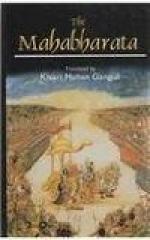“Brahma said, ’It is from Truth that all creatures, mobile and immobile, have been born. They live by penance (of action). Understand this, O ye of excellent vows. In consequence of their own actions they live, transcending: their own origin.[101] For Truth, when united with qualities, becomes always possessed of five indications. Brahman is Truth. Penance is truth. Prajapati is truth. It is from Truth that all creatures have sprung. Truth is the universe of being. It is for this that Brahmanas who are always devoted to Yoga, who have transcended wrath and sorrow, and who always regard Religion as the causeway (along which every one must pass for avoiding the morass below), take refuge in Truth. I shall now speak of those Brahmanas who are restrained by one another and possessed of knowledge, of the orders, and of those who belong to the four modes of life. The wise say that Religion or duty is one, (though) having four quarters. Ye regenerate ones, I shall speak to ye now of that path which is auspicious and productive of good. That path has constantly been trod over by men possessed of wisdom in order to achieve an identity with Brahman. I shall speak now of that path which is the highest and which is exceedingly difficult of being understood. Do you understand, in all its details, ye highly blessed ones, what is the highest seat. The first step has been said to be the mode of life that appertains to Brahmacharins. The second step is domesticity. After this is the residence in the woods. After that it should be known is the highest step, viz., that relating to Adhyatma.[102] Light, ether (or space), sun, wind, Indra, and Prajapati,—one sees these as long as one does not attain to Adhyatma. I shall declare the means (by which that Adhyatma may be attained). Do ye first understand them. The forest mode of life that is followed by ascetics residing in the woods and subsisting upon fruits and roots and air is laid down for the three regenerate classes. The domestic mode of life is ordained for all the orders. They that are possessed of wisdom say that Religion or duty has Faith for its




